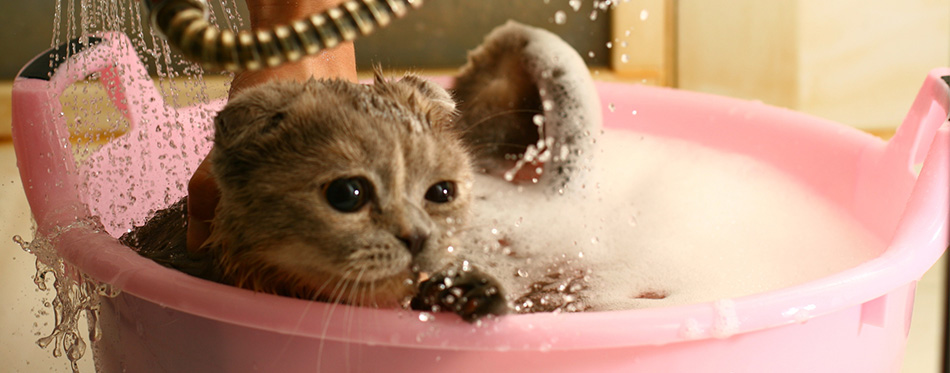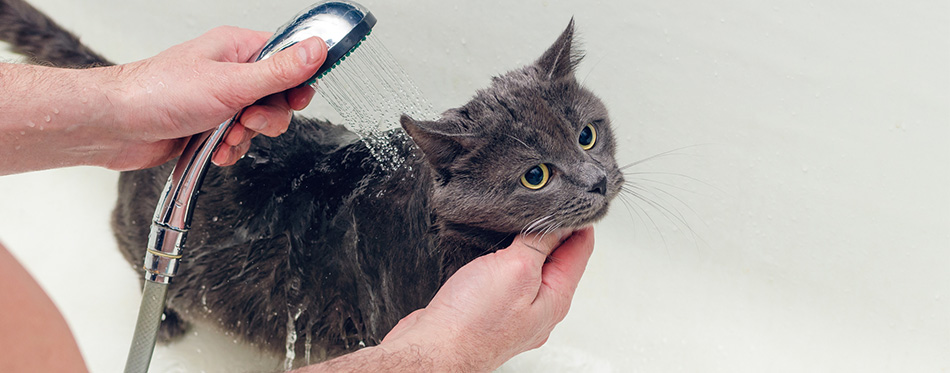If you’ve ever had a pet, you’ve probably experienced having them roll around in something they shouldn’t. Whether it is a puddle of mud or a patch of grass you just trimmed down, some pets just seem to have a knack for finding themselves in these kinds of places. When all of this is said and done, the most logical next step is to give your furry friend a nice bath. However, a lot of them don’t want to do this, especially cats. They fuss and they try to run away. Even if your cat likes to lick him or herself every now and again, in some cases that is not enough to really get them clean. Here’s how to convince them to take a much-needed bath.
Why Don’t Cats Like Water?
Before we discuss how to give your cat a bath, let’s first get into their mindset. Let’s talk about why they hate water. You often see tigers, leopards, and lions out in the wild enjoying a dip in the river. So why doesn’t your little one do the same as his or her distant relatives? This is because those bigger cats live in a much warmer climate compared to our domesticated felines. They go to the water to keep themselves cool. Some of them also go to the water to hunt for fish. However, house cats usually live in much cooler conditions. They also absorb, rather than deflect moisture, so they stay cooler for a longer time.

What You’ll Need
The first step in giving your beloved feline a bath is to prepare. Like the saying goes, “Preparation is the key to success.” You may need a couple different things here and there, which we will touch more on later, but most of the materials needed are more or less the same. To give your cat as pleasant of a bathing experience as possible, you’ll need the following: some rubber gloves to protect your hands, the best cat shampoo you can find, a cat conditioner if needed, a gentle spray nozzle or a pitcher for rinsing, a blow dryer or some drying towels, some ear cleaners, and a brush to remove tangled hairs. Find out more about cat brushes here.
Most people would attempt to give their cat a bath in the shower or in the bathtub. However, it is much easier to run a bath in the kitchen or bathroom sink. Why? You’ll save a lot of time and energy doing so. This is because there is less space for your pet to move around in and make the whole thing harder. Washing your pet in a sink is also easier on your back since you don’t have to bend over so much. If you can only use your shower or tub area, just be sure that you put a non-slip mat there to prevent any accidents from happening.
How to Give Your Cat a Bath
Start by filling the sink up with a couple of inches of lukewarm water. Around two or three inches of water will do. Remember not to make the water too hot, as this may hurt your precious pet. They may end up biting or scratching you if this happens. Gently place your cat into the water. Don’t drop or chuck them in there under any circumstance. Doing so will only serve to scare them even more than they already are.
If you can, simply spot clean your cat. However, if a full-on bath is needed, then make sure to wash the body separately from the head. The process of washing these two parts is considerably different from each other. Try to use only one hand to operate the spray nozzle or pitcher. Use the other hand to protect your cat’s eyes and ears from water and soap residue.
Let’s begin with the body. Once your cat has grown accustomed to the water, put it little by little on different areas of the body such as the shoulders and the tail. Don’t put too much at once, as this may startle your cat. This is also the perfect time to apply shampoo to the wet areas. Put a generous amount of shampoo for a deep clean, then lather and rinse thoroughly to avoid having any substance left over on your cat’s hair or skin. If you’re using a shampoo that has medication, leave it for a few minutes first to allow its effects to kick in.
Now that we’ve talked about how to wash your cat’s body, let’s now talk about how to clean his or her face. Most, if not all cats, absolutely hate having water unceremoniously thrown onto their head. Doing so may just make them hate taking baths even more in the future. This is why you should try a gentler approach. If you find that the spray nozzle or shower head you’re using is too powerful, the maybe you should try just using a wash cloth. Simply dampen a soft cloth and use it to wipe off any dirt from your cat’s face. Don’t use any shampoo.
Before drying off your cat, you should clean its ears, if possible. Don’t forget, under no circumstance should you try to put anything in your cat’s ears. Q-tips are not the way to go for pets. Using Q-tips to clean your cat’s ears could result in dirt and other unwanted substances getting pushed further down into their ear canal. This may cause something worse if left untreated. Instead, use a cotton ball to clean as much of your cat’s ears as you can. If there is something there you can’t reach, again, don’t be tempted to jam anything in. Rather, you should use a good quality ear cleaner.
You’re now ready to dry your cat off. Some pet owners use a blow dryer on the absolute lowest setting to dry their cats. This could work if you don’t have a lot of time, but the safest bet is to use a large towel to wipe off as much moisture as possible. Using a blow dryer could also work if you’re trying to dry a cat with long hair. Just remember that a hair dryer can get pretty hot, which could hurt your pet. They could also get very loud, which could scare some animals off.

Get the Best Materials for the Job
Now you know how to give your bath. However, you should also know how to get the best materials for this task. For instance, not any shampoo would do for cats, especially the ones you use for yourself. The best cat shampoo is made from all-natural ingredients and can be used on any fur color or type. You’ll also know that you have a good shampoo if it doesn’t irritate the eyes or sensitive skin. When buying a shampoo for your cat, try to look for one with added lanolin or proteins. This helps give your cat’s coat a more natural luster.
Similarly, you should try to look for the best drying towels your money can buy. Microfiber towels have been all the rage recently. This material is lightweight and durable. It also absorbs more water compared to the traditional cotton towels. It is also much easier to dry, as squeezing or wringing it already removes a majority of the water it soaked up. Microfiber drying towels come in different sizes to accommodate both smaller and larger animals. They also come in different colors and patterns that fit a cat’s personality.
Getting the best cat grooming gloves helps a lot as well. As mentioned before, these protect your hands from the cat’s teeth and nails if they start to get a little fussy. Good grooming gloves are gentle on your pet, but durable enough to handle their surprise attacks. Some gloves even have brushes built in to their surface, so you don’t have to whip out the brush at the same time. That’s multitasking at its finest. These gloves don’t break the bank either. While a good pair of cat grooming gloves may still seem expensive to some, their quality makes them a worthwhile investment in the long haul.
Get a good cat ear cleaner for your cat as well. Like we’ve said before, as much as possible, just use a cotton ball to remove grime from the surrounding area. If need be, use an ear cleanse solution to remove excess dirt and earwax. To use this, all you need to do is apply it into the cat’s ear canal. Once applied, massage the base of the ear to allow the solution to work its way into different areas. You could also let the cat shake its head around to help with this. Afterwards, wipe away the excess. Do not use ear cleaners if you think your cat’s eardrums are damaged. This could lead to an infection, so don’t risk it.
Now you know how to give your cat a proper bath. No more chasing your pet around the house and having them bite you every time you try to put them in the water. All you need to do is follow the steps listed above using the best materials you can possibly get your hands on.

